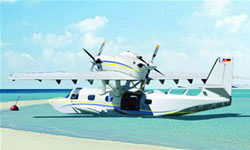 An unusual amphibious airplane, asleep for more than 15 years, may be resurrected under plans announced by Dornier Seaplane Company.
An unusual amphibious airplane, asleep for more than 15 years, may be resurrected under plans announced by Dornier Seaplane Company.
The new company, founded by Conrado Dornier, grandson of Dornier Aircraft founder Claude Dornier, plans to dust off the plans for the Seastar, a large, in-line twin-engine turboprop amphib that was certified in the early 1990s but never put into production. The Seastar, which can seat as many as 12 passengers plus two crewmembers, features a high wing with the two Pratt & Whitney PT6A-135A engines mounted tandem to one another in a push-pull arrangement and all-composite construction.
Since the production effort, only one of the two airplanes in existence has been maintained in flying condition. That airplane was recently flown from Germany to Florida where it is on display at the National Business Aviation Association convention.
Conrado Dornier hired Joe Walker as CEO. Walker most recently was president of Adam Aircraft and previously held positions at Gulfstream and Cessna. Walker said the composite fuselage solves many typical seaplane problems associated with leaking metal hulls and the related corrosion problems. He estimates the Seastar is the first large amphib certified in the last 50 years.
The company hopes to do final assembly in the southeastern United States; a location for the factory has not been set. That decision should occur by early 2009. They plan to produce one airplane by the end of 2010 and then five more in 2011 to establish the production certificate processes. Ultimately, Walker believes there is a market for about 30 to 50 aircraft per year.
The first airplanes will be priced at $5.5 million; later models with glass cockpits, air conditioning, and autopilots will sell for $6 million.
Since its inception, the Dornier family has invested some $150 million in the project. Walker estimates it will take that much again to reach profitability.
The airplane is nearly as large as a Beechcraft King Air 350 and has about twice the cabin volume of an amphibious Cessna Caravan. Dornier also plans to offer an “aquatic” version that does not have landing gear, saving about 200 pounds in empty weight.
Walker believes the market will be made up of individual owners who want to reach private yachts or island homes, commercial operators flying inter-island flights, and those needing to access oil rigs. The operating costs will be about half that of a helicopter.
The two 650-shaft-horsepower engines will propel the 10,000-pound airplane at 180 knots for up to 200 nm with nine passengers on board. With just two passengers, the range jumps to 700 nm.



